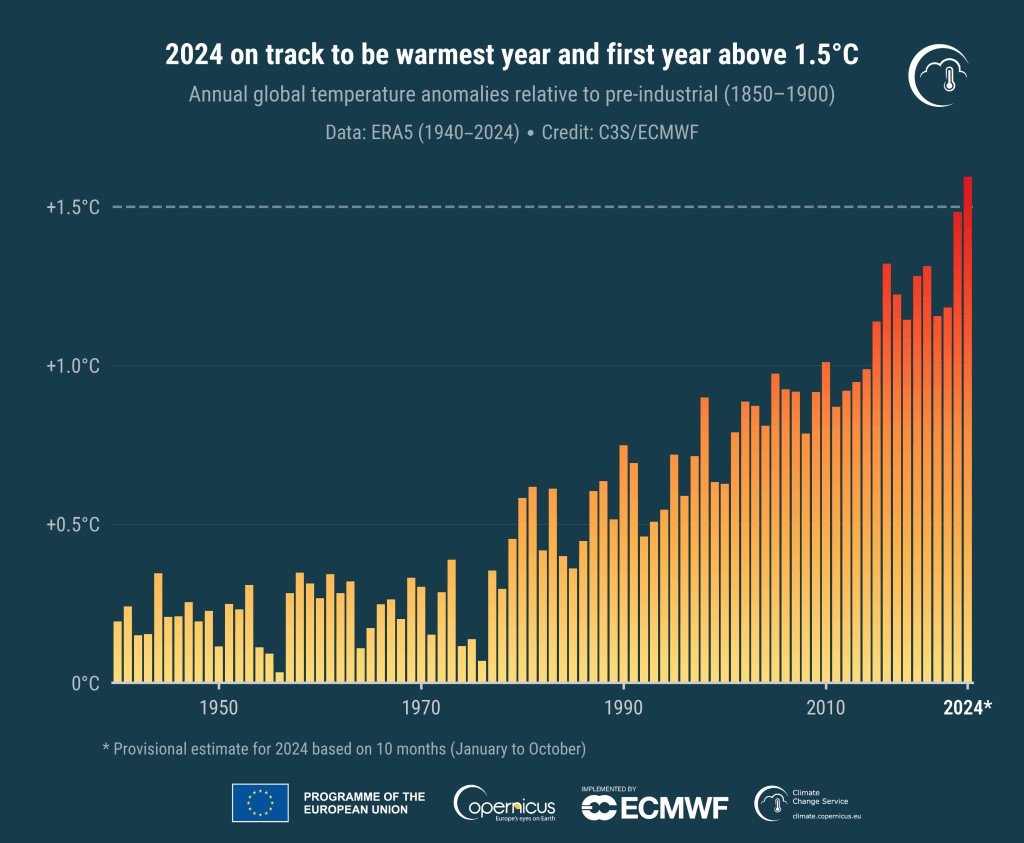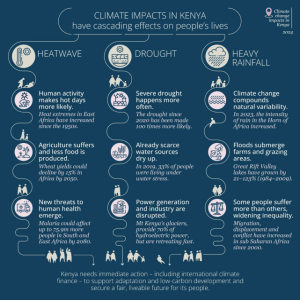Overview of climate change
The climate is changing. Global temperatures are rising, and extreme weather events are becoming more frequent. These changes are also noticeable in Kenya. Explore this page to learn how Kenya’s climate is changing, the effects of these changes, and the actions that can help minimize their impact.
What is climate change?
Climate is the average weather in a particular region, typically measured over 30 years. While the climate naturally evolves due to processes like volcanic eruptions, solar activity fluctuations, and changes in Earth’s orbit, human activities are increasingly driving climate change. The burning of fossil fuels, deforestation, and industry release greenhouse gases such as carbon dioxide (CO2) and methane (CH4) into the atmosphere, which trap heat and cause global temperatures to rise. The sixth report of the Intergovernmental Panel on Climate Change (IPCC) affirms that the current rate of global warming is primarily caused by human activities.

How are greenhouse gases causing global warming?
Through farming, industry, traffic, and energy generation, greenhouse gases are emitted into the air. As a result of the increase in greenhouse gases, Earth is warming at a rapid pace. This is due to the fact that greenhouse gases as carbon dioxide (CO2) and methane (CH4) retain the warmth of the Sun and reflect part of this heat to the surface of the Earth. This is referred to as the greenhouse effect. Without these greenhouse gases, Earth would be uncomfortably cold. Since the beginning of the Industrial Revolution in 1750, the volume of greenhouse gases has significantly increased. For example, the volume of CO2 in the air has risen by 40 per cent since 1750. In part, this can be attributed to the large-scale burning of fossil fuels such as coal, petroleum, and natural gas. Forest fires and logging are also contributing to the increase in CO2 volumes in the air. In addition, the quantity of other greenhouse gases – such as methane, which has much greater warming power than CO2 – has also increased significantly. Methane emissions have risen by no less than 150 per cent. Methane is primarily produced by cattle farms.
A simplified animation of the greenhouse effect. Credit: NASA/JPL-Caltech
How fast is the Earth warming?
Global warming is largely determined by the volumes of greenhouse gases being emitted now and in the future. The climate is currently changing at an extremely high pace and worldwide the temperatures are rising. According to NASA scientists, worldwide average temperatures have risen by 1.1 °C since 1880. The bulk of this rise has occurred after 1975; since then, temperatures have been rising by 0.15 °C to 0.20 °C every ten years. Over East Africa, the average temperature increased by 0.7–1°C between 1973 and 2013 (depending on the season).
What are the predictions for future warming?
Further global warming depends on greenhouse gas emissions. However, even if we manage to reduce emissions significantly, the temperature will continue to rise until at least 2050. According to the sixth IPCC report, global temperatures are likely to rise by more than 1.5 °C to 2 °C this century. The highest emission scenario even indicates that temperatures will rise between 3.3 °C and 5.7 °C by the end of this century. Results from the AGRICA project show that, depending on the future greenhouse gas emission scenario, air temperatures over Kenya are expected to increase by 1.2 to 3.2 °C (very likely range) by 2080 compared to the year 1876.
How is the climate in Kenya changing?
Global warming affects many processes of the climate system. For example, the frequency and variability of extreme events will change. These changes in climate are not expected to be uniform across the Earth. How is Kenya’s climate changing as a result of global warming? Below are the results of model predictions for climate change from the AGRICA project.
Extreme heat and heatwaves are becoming more frequent
Besides the fact that average annual temperatures are rising, it is very likely that the annual number of very hot days will also increase substantially, especially in central and eastern Kenya. Very hot days are days with daily maximum temperatures exceeding 35°C. In the medium/high-emission RCP6.0 scenario, the multi-model median, averaged across the country, predicts 25 more very hot days per year in 2030 than in 2000, 36 more in 2050 and 59 more in 2080. In some parts, especially northern and eastern Kenya, this rises to about 300 days per year by 2080. In recent years, heatwaves have already become more severe and longer lasting, with the Tana River, Garissa and Turkana counties the most affected.
Heavy precipitation is likely to become more frequent and more extreme
In response to global warming, heavy precipitation events are expected to become more intense due to the greater water vapor holding capacity of a warmer atmosphere. At the same time, the number of days with heavy precipitation events is also expected to increase. For Kenya, climate models predict an increase in the number of days with heavy precipitation, from 7 days per year in 2000 to 9 days per year in 2080 under the medium/high-emission RCP6.0 scenario. under the low emissions scenario RCP2.6, the number of days with heavy precipitation remains the same. In past years, the intensity of rainfall in the short rainy season seems to be increased. For example, the intense short rainy season over the Horn of Africa in 2023. In contrast, the long rainy season has shown a long-term drying trend.
It is still uncertain how average annual precipitation will change
Changes in annual mean precipitation are difficult to predict because of the large natural variability from year to year. However, the higher emission scenarios suggest a generally wetter future for Kenya.
There is a chance that drought will increase
Drought is caused by several factors, making it difficult to predict changes. Also considerable year-to-year variability and modelling uncertainty make it hard to predict. Although, researchers conclude when looking at changes in the past, that climate change has made events like the extreme drought that Kenya has been experiencing since 2020 much stronger and about 100 times more likely.
What are the effects of climate change for Kenya?
 The climatic changes occur at such a rapid pace that the Earth’s ecosystems cannot keep up. Climate change is impacting nature and humanity. What are the main impacts for Kenya? Changes in climate, especially heatwaves, rainfall and drought, are causing major impacts on health, living conditions, economy and the natural environment, among other things. The impacts for Kenya include:
The climatic changes occur at such a rapid pace that the Earth’s ecosystems cannot keep up. Climate change is impacting nature and humanity. What are the main impacts for Kenya? Changes in climate, especially heatwaves, rainfall and drought, are causing major impacts on health, living conditions, economy and the natural environment, among other things. The impacts for Kenya include:
Impacts on human health
Such as increasing heat-related mortality, increase in infectious diseases, and an increase in risk for malaria. For example, climate change is predicted to result in an additional 75.9 million people at risk from malaria in eastern and southern Africa by 2080, with the greatest risk in eastern Africa.
Impacts on nature and biodiversity – and consequently tourism
Climate change is expected to cause a substantial shift in vegetation, towards more shrubland at the expense of savannahs, grasslands and forests. Protected areas in Kenya could lose between 16% and 50% of their forests, depending on future emissions (Parracciani et al., 2023). There is also an increased risk of coral bleaching. All these changes on nature and wildlife may also impact the tourism industry, and thus the economy.
In response to globally increasing temperatures, the sea level off the coast of Kenya is projected to rise.
Under the RCP6.0 medium/high emissions scenario and compared to year 2000 levels, the median climate model projects a sea level rise by 10 cm in 2030, 21 cm in 2050, and 40 cm in 2080. This threatens Kenya’s coastal communities and may cause saline intrusion in coastal waterways and groundwater reservoirs, impacting agriculture, fresh water supplies, and biodiversity. It could even be catastrophic, since a 30 cm increase in sea level rise could submerge 17% of the city of Mombasa, Kenya’s second largest city and the largest seaport in East Africa (Awuor et al., 2008).
Climate change impacts agriculture and fisheries and threatens food and water security.
Climate change is predicted to result in a decline in wheat yields in Africa of 15% by 2050. For example, increased flows on large rivers are flooding farmlands, degrading soils and reducing farm output, with consequences for food availability. But also extreme temperatures and droughts decrease average crop yields and cause water scarcity. Between 1995 and 2019, the percentage of Kenyans living under water-stressed conditions already increased from 15% to 33% (Dinko & Bahati, 2023).
Migration, internal displacements and conflict may rise.
Due to increased occurrence of floods, droughts and extreme heat and their associated impacts on food, pasture and water resources migration, internal displacements and conflict may rise. Also (flash) flooding, landslides and the consequent impact to buildings and infrastructure may have devastating effects on vulnerable human settlements. But also economic production sites, especially in high-density urban areas such as Nairobi or Mombasa are particularly vulnerable.
The video below shows the impacts of heavy rain on the Kibera community in Nairobi. Floods destroy homes and infrastructure, but also affect human health through the spread of disease due to poor water quality. The community fights back.
How can we reduce climate change?
We can limit climate change by minimizing greenhouse gas emissions. This is also referred to as climate mitigation. In 2016, Kenya signed the UN Paris climate agreement. Under this agreement, close to 200 countries agreed to limit global warming to a maximum of 2 °C and to pursue a maximum of 1.5 °C. According to the sixth IPCC report, keeping global warming below 2 °C will require radical and large-scale measures within the next ten years. Kenya wants to make an ambitious mitigation contribution towards the Paris Agreement. Kenya therefore aims to reduce its greenhouse gas emissions by 32% by 2030 relative to the business as usual scenario of 143 Metric tons of carbon dioxide equivalent, and in line with her sustainable development agenda (United Nations Framework Convention on Climate Change, NFCCC). It is worth remembering that lower emission levels will not reduce global warming immediately: it takes about 20 years for the effect to be reflected in global temperatures.
How can we adapt to the effects of climate change?
To avoid major risks and climate damage, we must adapt to the effects of climate change. We can achieve this by making our urban and rural areas climate-proof and water-resistant. This is called climate adaptation. On the Measures page you can find more information about measures you can take to protect crops from climate change.
Vision 2030
Kenya Vision 2030 is the long-term sustainable development blueprint for the country and is motivated by a collective aspiration for a better society by the year 2030. It outlines a pathway to sustainable development aligned with the Sustainable Development Goals. The government has established national implementation frameworks for achieving Vision 2030 and provides technical guidelines for investing in low-carbon and climate-resilient adaptation and development. These mechanisms enable the government to define and engage local adaptation solutions at a community level. For example, the County Climate Change Fund is a mechanism that invests in locally led adaptation and promotes citizen engagement. The government has also established an emergency cash transfer program for vulnerable households during extreme weather events, such as drought and flooding.
The above video gives an introduction to climate change adaptation in Eastern and Southern Africa. Many examples of climate change adaptation are provided.
